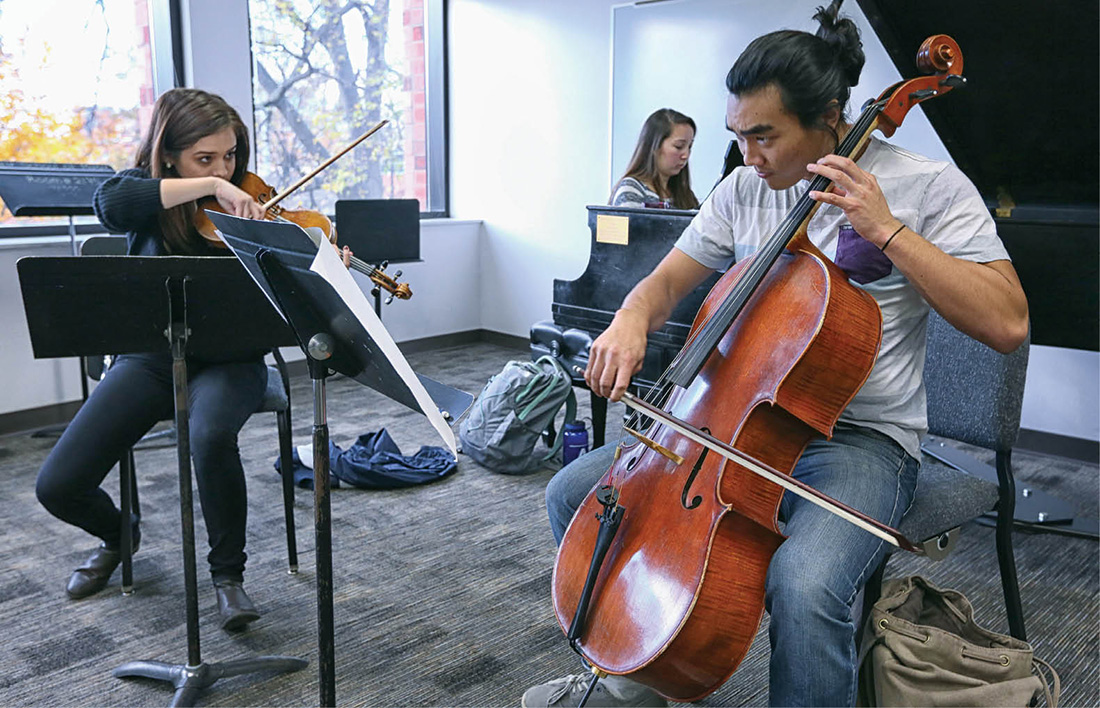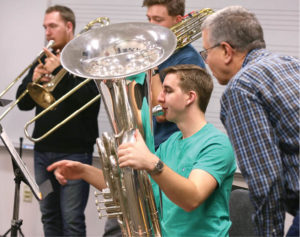
Musicians learn not only how to play an instrument, but how to play in a group, be it a full orchestra or a quartet. Learning to play in both large and small ensembles is part of the core curriculum at Vanderbilt’s Blair School of Music. However, the number of small ensembles forming to play each semester has grown from about 20 six years ago to 34 groups during the fall 2016 semester—an increase that reflects a growing student interest in playing chamber music, whether required in the curriculum or not.
“Most of our degree programs require playing in four semesters of chamber ensembles,” says Brian Utley, coordinator of chamber music ensembles and senior lecturer in saxophone. “They’re required to do it both semesters of their freshman year, and beyond that, they have to fulfill two more credits. But many of our students play six or even eight semesters, and that’s in addition to their large ensembles, individual lessons and other classes.”
Playing chamber music involves learning to play as one entity, without a conductor, in a group that may have up to nine members. These groups are coached by faculty at Blair—16 of them this year—but the instructors do not conduct the groups.
“That’s part of the experience for the students,” Utley says. “The general guideline is that the faculty member may coach once a week, and the student groups rehearse twice a week without the coach. We want them to learn how to make music on their own without constant instruction by the faculty. In the small groups they perform without a conductor, and they need to do it without someone there at every rehearsal. They enjoy having the opportunity to make their own musical decisions.”
Among other things, the students learn how to read the other players in the group.

“There’s a process during which the students learn the tendencies of one another, not just musically, but also visually,” Utley says. “They must learn how everyone moves to cue a downbeat or a cutoff. The emotional aspect of their playing also needs to be unified. They need to play as one, rather than as several players playing their individual parts.”
Performance opportunities for the groups have expanded as the number of groups has grown. Six years ago Blair scheduled two marathon evening recitals to incorporate all the groups. Then they moved to two or three shorter, afternoon recitals and a showcase recital of groups chosen by the coaches. This year the program moved to five afternoon recitals and one showcase recital requiring two days of auditions. “We are encountering so many more groups,” says Utley, “that even though we’ve gone to five recitals, some groups are still unable to perform because the slots fill up so quickly.”
Students who form their own groups frequently do so because they want to perform a certain repertoire or try an unusual instrumentation. Groups this fall included an ensemble that formed to play The Soldier’s Tale, a 1924 piece by Igor Stravinsky for a septet consisting of violin, bass, trumpet, trombone, clarinet, bassoon and percussion.
“Our chamber music runs the gamut from traditional ensembles—string quartets, wind quintets, brass quintets, saxophone quartets, piano trios—to a clarinet quintet, which is a string quartet with a clarinet,” Utley says. “This semester we had a group form for that instrumentation because they wanted specifically to do the Brahms Clarinet Quintet in B Minor.”
Because of the larger focus on chamber music in the curriculum, more students want to play and are initiating these groups on their own, despite their full schedules and the fact that they receive only one hour of credit or less.
“It could be one hour of credit or a half hour of credit,” says Utley. “In some cases students petition to do it for no credit because they want to be in an ensemble, but their schedule is full. They may be taking 18 hours, but they still want to play chamber music.
“That’s how much some of these students really want to do it. Many of them go above and beyond the required number of chamber ensemble credits they need.”